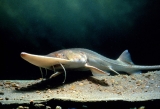- Home
- About S&T
- Taxa/Organisms
- Ecosystems
- Issues
- Methods & Tools
- Reports & Publications
- Location
- Search
Publisher: USGS | Science Center: Leetown Science Center (LSC, Kearneysville) | Format: URL
www.lsc.usgs.gov — This is a research project whose primary objective is to assess the health of selected fish species (brown bullhead and largemouth bass) and compare these findings with historic information on fish health in the individual rivers and with concurrent samples collected at reference sites. A secondary objective is to compare and correlate the fish More...

May 4 2007 | Publisher: Other (Springer New York) | Format: URL
www.springerlink.com — This project is an evaluation of three potentially nonlethal alternatives to fillet sampling for the determination of mercury (Hg) concentrations in smallmouth bass (Micropterus dolomieu) to monitor mercury concentrations in smallmouth bass (micropterus dolomieu) from six sites in southern Missouri were captured by electrofishing. Blood samples More...

2002 | Publisher: USGS | Science Center: Western Fisheries Research Center (WFRC, Seattle) | Format: URL
wfrc.usgs.gov — The value of this long-term monitoring program will provide data crucial for understanding demographic and reproductive characteristics of these endangered sucker populations. This research will have wide applicability to federal, state, and tribal agencies in the basin for management and recovery efforts.

2002 | Publisher: USGS | Science Center: Great Lakes Science Center (GLSC, Ann Arbor) | Format: .PDF
www.glsc.usgs.gov — In 2002, scientists from the Great Lakes Science Center assessed the health of the populations of preyfish for the biennial State of the Lakes Ecosystem Conference (SOLEC) to provide information to policy makers on the status of the lakes and future needs. Preyfish population is one of the 80 indicators used by SOLEC to determine the health of the More...

Publisher: USGS | Science Center: Florida Integrated Science Center (FISC, Gainesville) | Format: URL
fl.biology.usgs.gov — The African jewelfish (Hemichromis letourneuxi) has been established in canals surrounding the Miami area since the 1960s. With changes in water delivery to the park, the species has recently (2000) entered Everglades National Park and expanded its range westward through Big Cypress National Preserve. Simultaneously, African jewelfish from a More...

Publisher: USGS | Science Center: Western Fisheries Research Center (WFRC, Seattle) | Format: URL
wfrc.usgs.gov — An entrainment study at Grand Coulee Dam indicated that 200,000 - 600,000 kokanee were entrained, primarily at the 3rd powerhouse, during a 40-month time period. Following the recommendations of the Independent Scientific Review Panel, research was initiated to investigate a strategy to reduce entrainment by using strobe lights to repel salmonids More...

Publisher: USGS | Science Center: Western Fisheries Research Center (WFRC, Seattle) | Format: URL
wfrc.usgs.gov — The objectives of this study are 1) to determine how and when juvenile suckers use near-shore habitat with emergent vegetation, 2) determine how the distribution and abundance of juvenile suckers varies between near shore and offshore areas as well as between different areas of the lake over time, 3) determine if water quality conditions affect More...

Publisher: USGS | Science Center: Western Fisheries Research Center (WFRC, Seattle) | Format: URL
wfrc.usgs.gov — Mercury contamination from historic gold mining operations is widespread in many rivers, lakes, and reservoirs on the western slopes of the Sierra Nevada. A multidisciplinary investigation by USGS is attempting to better understand mercury dynamics and to identify hot spots within Camp Far West Reservoir in order to determine if remediation More...

Publisher: USGS | Science Center: Western Fisheries Research Center (WFRC, Seattle) | Format: URL
wfrc.usgs.gov — Lake Natoma, an 8,760 acre-feet reservoir on the American River, is managed by the U.S. Bureau of Reclamation (USBR) for multiple uses that include fishing and other water-based recreation. Preliminary results from 22 fish samples collected in Lake Natoma during August 2000 indicate that the mercury content may approach or exceed guidelines for More...

Publisher: USGS | Science Center: Western Fisheries Research Center (WFRC, Seattle) | Format: URL
wfrc.usgs.gov — Artificially maintained water levels within the lake and stresses placed upon the aquifer by well withdrawals facilitate movement of water from the lake into the local ground water system, potentially allowing contaminants to enter the aquifer from the lake. This raises national concern because similar lakeside settings exist throughout the United More...

Publisher: USGS | Science Center: Florida Integrated Science Center (FISC, Gainesville) | Format: URL
fl.biology.usgs.gov — Southeastern Aquatic Fauna studied at the Center are freshwater, anadromous and estuarine fishes, and freshwater mollusks, with expertise in the study and conservation of the southeastern aquatic fauna, including freshwater fishes and mussels. The Southeast Aquatic Faunal Team provides critical information necessary to assess the status of this More...

Publisher: USGS | Science Center: Biological Informatics | Format: URL
biology.usgs.gov — This page presents samples of genetics and genomics research from the USGS Biological Resources Discipline about the conservation genetics of fish.
